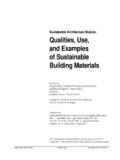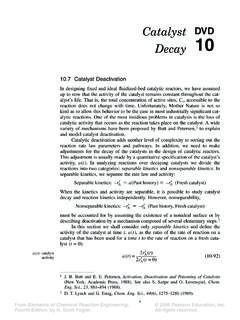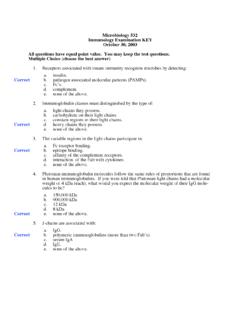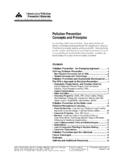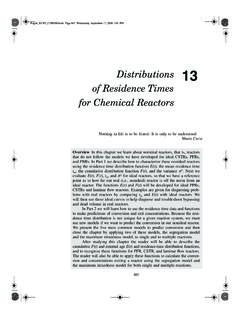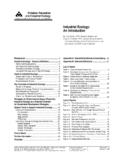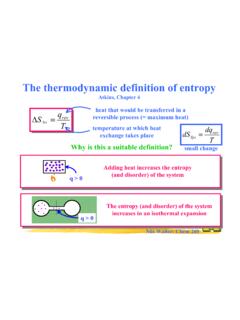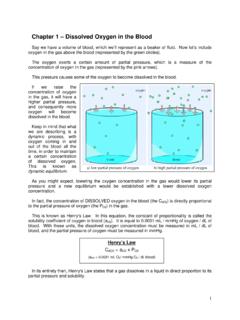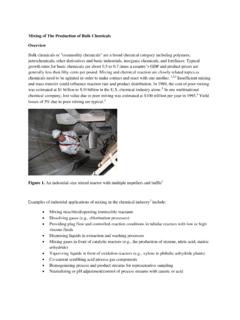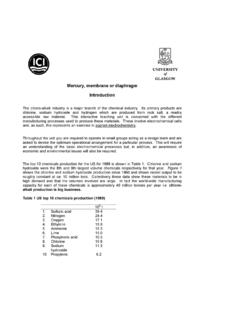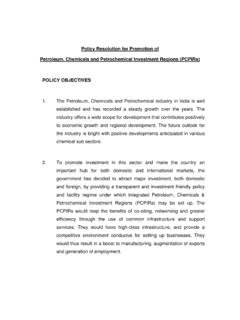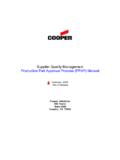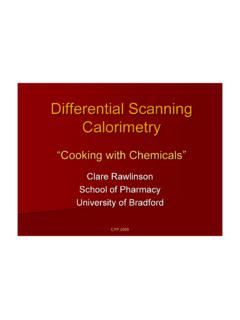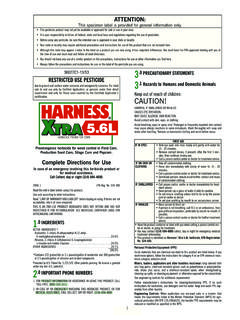Transcription of V. CASE STUDY: COMPARISON OF ETHYLENE …
1 V. CASE STUDY: COMPARISON OF ETHYLENE glycol VERSUSPROPYLENE glycol -BASED ANTIFREEZE SOLUTIONSA. IntroductionThis case study demonstrates the quanitative and qualitative informationcollected through application of the multi-disciplinary life cycle frameworksuggested in the previous section of this document. It analyzes the productionand utilization trade-offs associated with ETHYLENE glycol (EG; 1, 2-ethanediol)and propylene glycol (PG; 1, 2-propanediol) based antifreeze products. Speci-fically, the case study focuses on their use in water-based coolant systems ofinternal combustion engines1. Additional components added to antifreezeproducts include corrosion inhibitors, anti-foaming agents, coloring agents, andmetal and glycol antioxidants (66). The following chemical constituents of EGand PG-based antifreeze formulations are considered in the Franklin Associates,Ltd. (FAL) study2:PG-BASED ANTIFREEZE% OF TOTALEG-BASED ANTIFREEZE% OF Tetraborate Orthophosphate term antifreeze product refers to the above undiluted chemicalformulations.
2 Antifreeze products are diluted with water, typically in a 50/50ratio, prior to being added to the cooling systems of internal combustion term antifreeze solution refers to aqueous mixtures containing 50% waterand 50% antifreeze product3. These definitions apply throughout this case studyunless indicated otherwise in the text (55, 56).1 Related applications of EG and PG-based products includes their use in refrigeration systems,heat transfer and water heating systems, building air conditioners, solar energy units, automaticsprinklers, snow melting equipment, deicing fluids for planes, water-based paints,pharmaceutical products, and freeze drying apparatus (66, 67, 68, 69).2 Percentages are based on approximate weights of chemical constituents in antifreeze solutionpresented in Table 11 of this case study (55).3To normalize the solutions for freeze protection, FAL uses a dilution ratio of 53% PG product /47% water in its COMPARISON . Results in the case study indicate which dilution ratio data regarding the life cycle of PG and EG antifreeze solutions arelimited due to its proprietary nature.
3 Therefore, some aspects of the analysisrefer to specific reaction steps, while others apply to the entire life cycle of thesesolutions. All information obtained from FAL considers the full life cycle of thesechemicals. This includes raw material extraction, production of PG and EG,manufacture and disposal of primary and tertiary packaging, filling, disposition,and disposal of spent antifreeze product (55). Data generated in the FAL studyapplies to the following production processes for these chemicals4:PG PRODUCTIONH ydrolysis of propylene Oxide (PO) in WaterEG PRODUCTIONH ydrolysis of ETHYLENE Oxide (EO) in WaterPO PRODUCTIONW eighted Average of Chlorohydrination, IsobutaneHydroperoxidation, and Ethylbenzene HydroperoxidationEO PRODUCTIONC atalytic Oxidation of EthyleneOther aspects of this case study designate applicable reaction steps. Systems notexamined in the FAL study include fuel, energy, and waste associated withproduction and use of capital equipment, space conditioning, support personnel,and miscellaneous materials and additives that are less than 1% of the netprocess output (55).
4 B. Data Collection MethodsData collection activities are based on the inventory analysis stage of a LCA,but are not limited to environmental and health-related impact data categories include quantification of reaction inputs and outputs,energy requirements, residuals associated with production and utilization,properties of reaction inputs and outputs, reaction economics, and regulatoryrequirements. Data sources include general literature on antifreeze solutions andconstituent chemicals, reference texts, interviews with chemical industrypersonnel, and two chemical industry subscription databases published byStanford Research Institute (SRI). These databases, which include the ChemicalEconomics Handbook (CEH) and the Process Economics Program (PEP), are4 All data regarding EG-based antifreeze presented in the FAL study is calculated based on a average. Similar data for PG-based antifreeze are calculated using a weighted averagefor production capacity of the following PO processes: isobutane hydroperoxidation ( ),ethylbenzene hydroperoxidation ( ), and chlorohydrination ( ).
5 38available for use by private corporations and some educational institutions. Inaddition, a LCA and partial impact analysis, published by Franklin Associates,Ltd. (FAL) in August 1994, is the primary resource for data related to energyconsumption, environmental emissions, and reaction Theoretical Needs AnalysisAlternatives to EG and PG should be first considered as the basic componentof antifreeze solutions. Prior constituent chemicals of antifreeze solutionsincluded denatured ethanol, synthetic methanol, isopropyl alcohol, glycerol,calcium chloride and other salt solutions, honey and sugar solutions, andhydrocarbon oils such as kerosene. Typically, product availability, rather thancost and performance, was the criterion for using these various World War II, ETHYLENE glycol and methanol were primarily utilized invehicles in the and Western Europe. By 1970 EG-based antifreeze solutionswere used almost exclusively by automobile manufacturing all over the main factor for displacing methanol-based products was higher engineoperating temperatures, which yielded superior space heating capacity and slightimprovements in fuel efficiency.
6 Recently, propylene glycol -based antifreezeproducts have became popular for use in automotive cooling systems, solarenergy collectors, cooling systems of engines operating potable water systems,and refrigeration systems for food and dairy products (66). See Appendix 4 foradditional information related to the use of EG and PG-based antifreeze solutionsas a coolant of internal combustion and other aspects of the reaction system that extend the useful lifeand/or enhance product performance should also considered. In terms ofantifreeze products, the type and amount of formulation chemicals, other thanthe glycol component, will determine the effective product life. Useful lifeextension of antifreeze products may reduce the number of times consumersreplace these solutions, thereby decreasing the number of potential adverseexposures. The feedstocks for both glycol chemicals are derived from non-renewable petroleum and natural gas resources. There are no alternativesynthetic pathways for PG or EG that utilize biological or other renewablefeedstocks identified at this , evaluation of the overall need for antifreeze solutions should alsooccur prior to analysis.
7 Internal combustion engines fabricated with materialshaving greater heat absorbent properties, such as ceramics or composites, could39lessen or eliminate the need for engine coolant systems. If these options areavailable the analyses should focus on comparing alternative engines fabricationmaterials with traditional ones. Relevant information regarding advancementsin fabrication materials for internal combustion engine was not a part of this casestudy. However, it could be the focus of research efforts if they become a viableoption in the Production SummaryFigure 4 summarizes the production processes for both ETHYLENE glycol (EG)and propylene glycol (PG) based antifreeze solutions. The specific EG and PGreaction steps utilized in this case study are described in Appendix 5. Both EGand PG are produced from the refining of crude oil and natural gas. They areprocessed at an ETHYLENE cracker into propylene and ETHYLENE feedstocks. Inaddition, off gases from the refining process may contain recoverable propylene ,which can be diverted to PO production facilities.
8 (69). In 1993, 73% of ethyleneand 28% of propylene were produced from natural gas liquids and refinery off-gases, and the balance was produced from crude petroleum feedstocks (70).Figure 4: Summary of Production Processes ofEG- and PG-Based Antifreeze SolutionsRefineryHeating Oil and GasolineEthylene CrackerPetroleum Refinery Off Gases Crude PetroleumNatural GasNatural Gas LiquidsEthyleneGlycol PlantPolyolefinsPlantEthyleneEthyleneOxi de PlantPropyleneOxide PlantEthyleneOxidePropyleneOxidePropylen ePropyleneGlycol PlantEthyleneGlycol*PropyleneGlycol*NOTE : * Undiluted EG and PG feedstocks are sent to a formulation facility where they are combined with corrosion inhibitors, anti-foaming agents, and other additives. This final formulation is packaged and shipped to retail outlets or shipped in bulk for packaging by and propylene are then processed into ETHYLENE oxide (EO) and pro-pylene oxide (PO), respectively. Present production facilities in the convertethylene via catalytic (silver) oxidation to EO.
9 The traditional chlorohydrin pro-cess is being replaced by this direct oxidation process due to unfavorable reactioncosts and production of chlorine waste water. Alternate routes of production arepresently under development, but these processes are not appropriate forindustrial applications5 (71). PO production facilities utilize the chlorohydrinprocess, co-product processes (isobutane hydroperoxidation, ethylbenzenehydroperoxidation), hydrogen peroxide routes, and direct oxidation (72).Following production of EO and PO, both chemical intermediates are convertedinto their glycol equivalent through similar hydration processes. Both reactionsproduce higher glycols (di, tri, tetra) because the mono-PG/EG products cannotbe removed from the reactor quickly enough. However, these additional glycolproducts are separated from the desired mono- glycol counterpart through a seriesof distillation and purification processes (68). Following these steps, PG and EG areshipped to regional formulation and packaging facilities.
10 The formulation processoccurs in a batch operation utilizing tanks equipped with agitator and heating coilsto facilitate dissolution of additives. The final EG/PG-based antifreeze product isthen packaged and shipped to retail and commercial locations (66).At the present time there are no viable alternative feedstocks, other thancrude oil and natural gas, which can be utilized in the production of EG or PG-based antifreeze. Current research focuses on optimizing reaction conditions andreducing the energy consumption of reactions through the use of alternativecatalysts. The abundant supply of present feedstock sources, existinginfrastructure, and reasonable price have not justified additional research onnon-petroleum sources (67, 69).E. Quantification of Reaction Inputs and OutputTable 11 compares component weights for reaction inputs, antifreeze products,and packaging material associated with 1000 gallons of EG and PG-based anti-freeze solution.
